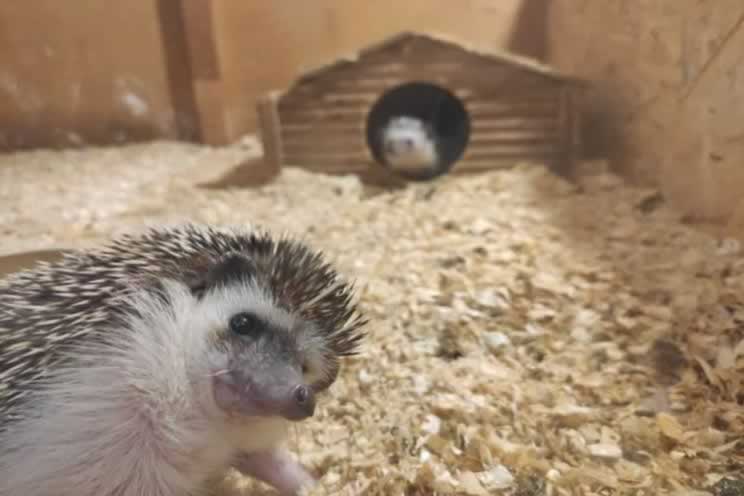
A hedgehog’s cage set up is extremely important as they need a safe environment to keep healthy. Many problems can arise if the cage is missing essential items.
What do hedgehogs need in their cage? Hedgehogs need heating like a heat mat or heat lamp, suitable bedding, housing, a running wheel for exercise, a feeding bowl, a water bowl or dispenser, a toy like a ball with bells, with an optional litter tray for them to use. Some owners include fabric tunnels for crawling.
Let’s look in detail at the items hedgehogs need in their cages in the rest of this article.
1. Heating
Cages need a good reliable source of heat for the colder months of the year. Hedgehogs originate from warmer climates and when kept as pets they have not evolved to deal with the colder temperatures experienced in many western countries. If they become too cold they can go into hibernation which can prove fatal.
Do Hedgehogs need a heat lamp?
Heat lamps can be used to provide heating for hedgehogs as long as a few precautions are taken:
(i) The cage should not be a fire risk from the heat emanating from the heat lamp as some plastic cages could end up melting, catching fire and seriously injuring hedgehogs. Fire risk applies to other items in the cage made from materials that can easily catch fire or melt.
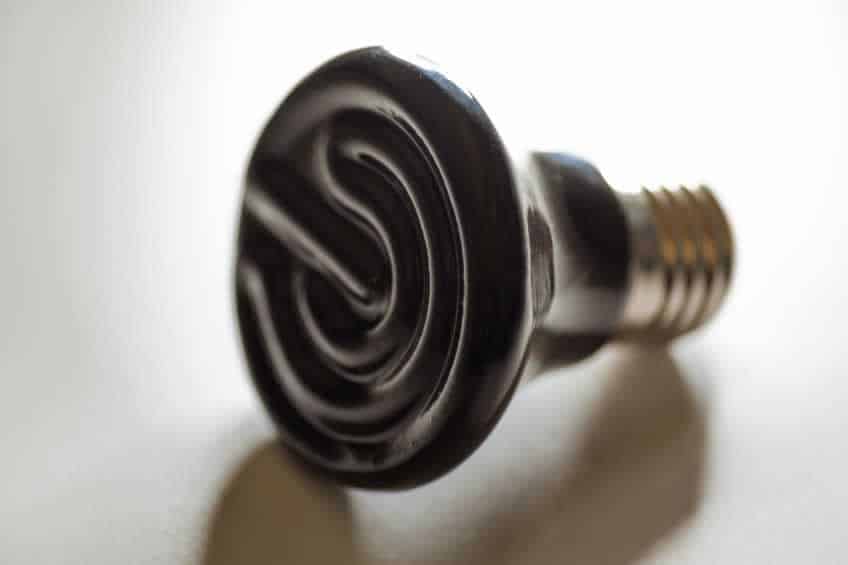
(ii) The heat lamp should not emit any light and should only provide heating. Heat lamps emitting light may be fine for reptiles and amphibians but for hedgehogs, this is going to be problematic.
The light will probably stop the hedgehog from coming out at night being confused by the light from the heat lamp and assuming it’s still daytime.

(iii) The heat lamp must be firmly held in place using a heat lamp holder, that is stringent enough to keep the heat lamp in place. Otherwise, the heat lamp could fall and cause injury to the hedgehog.
(iv) A guard is put around the heat lamp to protect the hedgehog from injury from burns. Heat lamps are generally mounted to the top of the cage or can be suspended from the cage ceiling.
Some form of guard needs to be placed around the heat lamp to minimize injury to the hedgehog, should the heat lamp fall or the hedgehog tries to reach the heat lamp.
Are heating pads safe for hedgehogs?
Using a quality heating pad also known as a heat mat for a hedgehog is safe, as long as there is a thermostat to regulate the temperature using a thermometer to get the cage temperature. Electrical sockets with power surge protection must be used.
We have a plastic cage and using heat lamp would be a fire risk, so use the heat mat shown in the picture below:

The heating pad has a fabric cover to not only protect the hedgehog from the heat but also to provide an easy way to clean, by simply unzipping the cover off and putting it in with the washing.
Heat pads need to have strong cable casing from the cables that come out of the heat pad as hedgehogs may try to chew on the cables. Otherwise, they could get electrocuted if they accidentally chew through the cables.
How warm should an hedgehogs cage be?
At a minimum, steps need to be taken to ensure the temperature in the hedgehogs cage is between 72F (22C) and 80F (26.5C) but this doesn’t necessarily mean the whole cage has to be heated to this temperature.
We’ve learnt from experience as long as the main parts of the cage are within these ideal temperatures, our hedgehog seems to be fine.
Cage thermometer
The temperature inside the cage is the most important as this can vary from the outside temperature and depending on the cage chosen the inside temperature may actually be lower than the outside temperature.

There’s only one sure-fire way of determining what the inside temperature of the cage is and is by using a thermometer. We have a thermometer with a suction cup that sticks to the inside of the cage, away from our hedgehog so he doesn’t end up chewing on it.
Thermostat control
We use a thermostat to automatically control the temperature of the heat mat in our hedgehog’s cage. The thermostat connects to the thermometer which we’ve placed inside the cage, so the thermostat is aware of the temperature inside the cage and when it falls below 72F (22C), the thermostat switches on the heat pad in our hedgehog’s house.
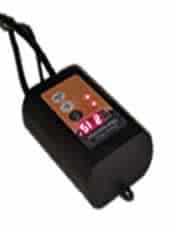
We’ve also set a maximum temperature at which the thermostat turns off the heat mat at around 80F (26.5C), this at first doesn’t seem necessary as the heat mat wouldn’t be on in the first place if the temperature is above 72F (22C), but as a precaution should the heat mat malfunction and start heating up, hopefully, the thermostat will kill off the power.
What temperature is too cold for hedgehogs?
Hedgehogs can cope with temperatures slightly lower than 72F (22C) but anything lower than 64.5F (18C) may spell trouble as they may start to exhibit pre-hibernation symptoms. Symptoms such as being cold to touch, lethargic, unable to stand up
We spent the time to make sure our little guy was not being exposed to cold drafts at his level by checking to see if any cold drafts were coming into the room near his cage.
By using a candle, we checked to see if the flame flickered as this could point to drafty cold air seeping into the room and fortunately for all of us, the family room is good at keeping the cold out.
We also move the cage in the colder months to the other side of the room away from the windows as a measure to ensure the heat loss from the windows doesn’t affect the cage.
If you do find areas of cold air seeping into the room where you plan to keep your hedgehog then draft exclusion products may be able to provide a way to keep these cold drafts at bay.
2. Bedding
The correct bedding is also required to not only provide the hedgehog with a layer to keep out the cold from the base of the cage but something that’s easy to clean the mess the hedgehog leaves on a nightly basis.
What do you put on the bottom of a hedgehog cage?
A hedgehog cage needs bedding made from fabric or wood-based or paper-based on the bottom of the cage to not only provide some insulation against the cold of the cage floor but also to provide an easy way of collecting their fecal matter and urine.
Having no bedding in a cage will make the cage slippery from the poop and pee, causing injury and once this poop dries onto the base of the cage, it requires more effort to clean. With bedding, you simply swap it out or replace it.
What is the best bedding for ahedgehog?
There are many different options for bedding with some being more suited to hedgehogs, whilst others can be dangerous and toxic to them.
Wood-based bedding
Some types of wood chippings and pellets can make good bedding for hedgehogs as long as the wood is not toxic and the wood doesn’t contain any toxic oils.
Much of the wood-based bedding is marketed as dust-free or low dust and this can keep the hedgehog irritation-free from the lack of dust.
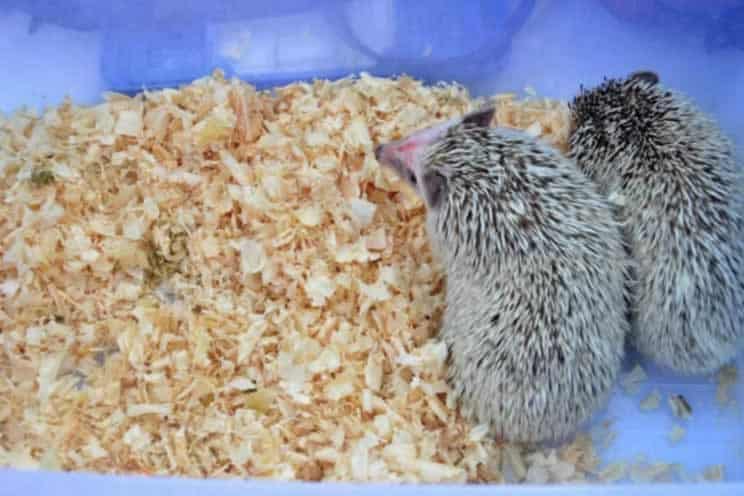
Be careful of odour free type wood-based bedding as this normally contains scents to mask the smell of the hedgehogs poop and pee and this scent could be irritating to the hedgehogs highly sensitised sense of smell.
Wood-based bedding can soak up their pee pretty well and any water spilt on it from mishaps at their drinking bowl. This makes it good at masking some of the pee smell in comparison to other types of bedding.
Wood chips are a relatively cost-effective bedding option and existing wood chip bedding is simply replaced by new.
Wood-based cat litter can also be used but it’s a bit tricky for hedgehogs to walk over as it doesn’t provide a level surface for them to walk on.
Otherwise, wood-based cat litter bedding has an excellent ability at soaking up pee and any water spilt, as well as being low dust.
Fabric-based bedding
We use fabric-based bedding by providing a thick fleece-lined blanket on the base of our hedgehog’s cage.
This needs to be changed at least twice a week as it can start to smell with the poop and pee on it. Originally we used a litter tray and found the bedding could be changed once a week but litter tray took up too much space in the cage, so we removed it and took the hit with him doing his business on the bedding.
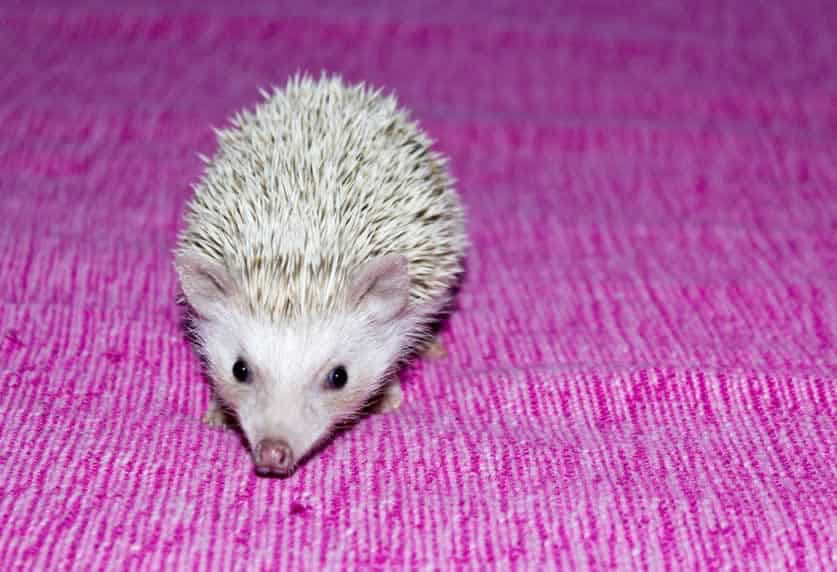
It’s also cheap and environmentally friendly as we reuse the bedding after washing it in an ecologically friendly detergent.
What bedding is bad for hedgehogs?
There are types of bedding that are a poor choice for hedgehogs and must be avoided.
Sawdust
Sawdust doesn’t make a good choice for bedding as it’s quite dusty and I wouldn’t want any hedgehog to have to breathe in any dust not just when they are moving around but when they are sleeping too.
I wouldn’t want them to get sawdust in their eyes either and make their eyes irritated. The irritation could also affect their skin from the dust and them to scratch more to appease the dust nuisance.
I find sawdust very messy and thinking about having to remove it from a cage and replace it with fresh sawdust regularly, doesn’t make me keen to use it.
Gravel
I’ve not seen or heard of any hedgehog owner using gravel but I’d thought I’d add it to highlight how what looks like ok bedding can be a bad choice.
Gravel is uncomfortable for hedgehogs to walk on and could be dangerous and lead to injury. I would also think it would easily retain more of the cold in the colder months so not inspiring the hedgehogs to walk across it as much they should be.
Cedarwood bedding
Anything with Cedarwood is toxic to hedgehogs and must be avoided. Other types of wood can be fine but only if any of the oils they contain have been sealed and don’t leak out, as the preserving oils can be toxic to hedgehogs.
Can I use sand for hedgehog bedding?
Sand can be used for hedgehogs but would cause problems trying to clean it regularly. The sand would need to be replaced each time, as removing fecal matter and urine soaked sand would be time consuming and difficult.
An inch or two of sand at the bottom of a cage would also not only make the cage much heavier, requiring more effort to move but also the thought of having to scoop all that sand out when it’s also covered in poop and pee doesn’t bear thinking about.
It would make cleaning the cage an absolute chore and this would probably set up a few arguments over who should be doing it next. Cleaning needs to be easy so children don’t struggle and learn some responsibility too.
Hedgehogs do like to burrow into the sand and this will also get sand in their fur and spines. Bath times would be quite messy getting the sand out especially the sand that’s been soiled and stuck to their bodies.
Can you use newspaper for hedgehog bedding?
Newspaper for hedgehog bedding is used by some owners but care is needed to ensure the newspaper ink isn’t toxic. Newspaper bedding would need to be replaced regularly as water spills, urine and fecal matter will soak into the newpaper.
We also tried newspaper bedding early on but found it would start to break up when water and pee ended upon on it as he moved around the cage, forming into mushed up areas.
We weren’t comfortable with the idea of the newspaper ink and it’s possible toxicity if Hynee tried to chew on the paper.
We also considered shredding the paper using our paper shredder but it was too much effort compared with fabric bedding.
My daughter can handle changing and putting fabric bedding in the washing machine in just a couple of minutes instead of having to have to remove the newspaper bedding and then clean the cage floor.
Can I use hay for hedgehog bedding?
Hay may seem like a good option, likewise straw too but it’s important to appreciate hedgehogs may get injured with this type of bedding especially if their limbs get wrapped in hay or straw, leading to cuts or circulation is stopped. In worse case scenarios this could lead to amputation.

Hay may also have been subjected to pesticides and having a hedgehog rummage through something with pesticide residue just doesn’t sit right with me.
Grass is also another poor choice I think, as it’s not good retaining heat, getting cold quickly and is quite messy. Worse still if the grass is being brought in from the garden then who knows what other bugs and nasties are being allowed to live with the hedgehog too.
How deep should hedgehog bedding be?
As we use fabric-based bedding the depth of this is about half a centimetre at most. With bedding made of pellets or shavings, an inch or two should be enough, with care taken to ensure the hedgehog isn’t impeded in its ability to move around the cage.
Bedding needs to be able to accommodate other items in the hedgehog’s cage and having uneven bedding with an exercise wheel on top could be outright dangerous. As the risk of injury from the wheel tipping onto the hedgehog or the hedgehog falling from an unbalanced wheel will increase.
What bedding should I put in an hedgehog house?
Sometimes the choice of bedding for the cage might not be suitable as bedding for where the hedgehog sleeps such as using cat litter pellets made from wood.
In this case, a different bedding option for inside the cage, such as fabric-based may be more suitable as the hedgehog may struggle to sleep on pellets, finding it uncomfortable. Even putting a sleeping pouch on top of pellets inside their housing may not give them the comfort they need to relax and sleep.
Down to choice and how much you’re willing to pay. Reusable bedding is cheaper especially for us as we change our hedgehogs bedding twice a week. Disposable bedding can end up being expensive and isn’t environmentally friendly as reusable bedding.
3. Exercise equipment
Some form of exercise equipment is vital in keeping them healthy and avoiding them from gaining weight and becoming obese. Hedgehogs need exercise to remain healthy and keep their active minds in check. In the wild, they cover several miles a night as they forage for food and as pets, they need to be able to walk and run a lot.
Exercise wheels also known as running wheels provide them with the best exercise, allowing them to walk and run several miles a night.
What is the best exercise wheel for an hedgehog?
Any exercise wheel chosen needs to be safe for the hedgehog to use when they are walking and more so when are running on the wheel at speed.

A flat surface is essential so the hedgehogs don’t end up injuring themselves as they are running. Some exercise wheels have small ridges placed evenly across the inside of the exercise wheel, spaced apart by an inch or so.
These ridges don’t tend to pose a risk along as they are very small and don’t impede the hedgehog in any way during their walks or runs. The ridges provide additional grip for them as they use the exercise wheel so when they slow down from a run, they don’t just slide off the exercise wheel.
When choosing an exercise wheel it’s imperative the wheel doesn’t contain any parts where the hedgehog’s feet can get stuck, leading to injury.
Choosing a meshed or metal wired wheel is a bad choice as the hedgehog’s feet can easily get caught in the gaps between the meshing or metal wiring, leading to injury.
We paid a bit extra and got a better quality exercise wheel so that it would be quieter when it was used. The silent spinner type wheels are great and if noise is going to be a problem for you then I’d recommend these silent type wheels, as the cheaper ones may drive you nuts with l the noise they make.
The size of the exercise wheel is important, as it’s got to be deep enough so the hedgehog doesn’t fall out and have a large enough diameter to make it easy for them to use. About 4 inches deep and a diameter of 10 inches should be the bare minimum.
Can hedgehogs use exercise balls?
Balls especially the ones with little bells inside are great for hedgehogs, making a little ringing noise as they push them around or bump into them.

Other types of balls like ping pong balls (table tennis balls) and other plastic balls are great. Take care in ensuring the balls aren’t made from anything toxic and are strong enough to take the wear and tear of pet hedgehog use including being chewed or peed on.
What size ball does a hedgehog need?
A ping pong size ball is ideal for hedgehogs, allowing them to push the balls easily. Larger balls can be used but they may be impractical to keep in their cages due to size limitations. However, would be quite acceptable for use when the hedgehog is brought out into a penned area inside.
Do hedgehogs run in balls?
There are balls available allowing the hedgehog to run inside causing the ball to move. This isn’t something I would buy our hedgehog or something I would advocate.
My biggest concern is the hedgehog becoming covered in their own filth as they do poop and pee when they walk and run. They’d also have to breathe in the smells of their own waste and I wouldn’t want to wish that on our hedgehog.
4. Toys
As well as physical health, toys are a good idea to help with their mental health and keep their minds active. Just chasing a toy like a ball makes a big difference in their lives.
Can hedgehogs play with cat toys?
It’s important to ensure any cat toys haven’t been used by a cat before giving them to hedgehogs. As the scent of a cat on the toy can make hedgehogs distressed and they may become aggressive to the toy and bite the toy as they see it as a predator. To stay on the safe side any cat toy should be brand new.
Any cat toy needs to be able to withstand the wear and tear of hedgehog use. They will try to chew it and their teeth are quite sharp.
What are good toys for hedgehogs?
Small balls like ping pong (table tennis) balls tend to be good toys for them to play with. We also have a little teddy bear in his cage but don’t really know if this is something he does play with.
Any toy must not be toxic to hedgehogs so make sure you research the toys thoroughly, especially considering cheaper toys may contain chemicals that reputable manufacturers would never use.
Pens and tunnels
In the spring and summer months, we set up a pen of about 6 feet by 6 feet, walled off with metal fencing (only use this under supervision so we know our hedgehog is safe at all times).

We put in a plastic tunnel bending it twice into an s-bend. Placing food at one end, maybe a treat and when he manages to crawl inside and start exploring, eventually he gets the smell of the food come his way and he darts up to it to chomp it down. You can also use a fabric-based tunnel instead of a plastic one.
5. Housing
Pet hedgehogs need a place to hide and sleep that gives them the reassurance of feeling safe. The right type of housing can provide a safe place to sleep and should also be easily and quickly accessible when they need to hide.
Igloos
We use an igloo house made of plastic that allows us to easily peer in and see. We have found the igloo house exceptionally easy to clean and it sits nicely on top of the heat mat, providing a nice warm snug place for Hynee to retreat to.

We normally put a fabric blanket over the top of Hynee’s igloo to give him some darkness to sleep in, with any light only creeping in slightly at the edges of the blanket, so he’s aware when it’s daytime and night.
Sleeping Pouch
We use a sleeping pouch placed inside Hynee’s igloo house, allowing him to sleep in a dark place as the igloo house is transparent plastic so let’s the light in.
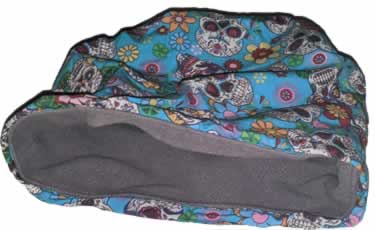
The sleeping pouch is used well during the colder months as it’s on the heat mat, so it’s almost like his own duvet but he gets into it and not under it. When it becomes a little less cold, he’ll sleep on top of the sleeping pouch.
Wooden Houses
Our local pet shop stocks many different wooden houses for different pets and these can be a good home for a hedgehog. They need to be large enough to accommodate the hedgehog and also made from a wood that’s safe and not toxic to hedgehogs. Some types of wood may be safe for other types of pets but might not be safe for hedgehogs.
Multi-level Housing
This type of housing has two levels with the house at bottom and an area on top for the hedgehogs feeding bowl and water. This type of housing does increase the free space in the cage at the cost of safety I think.
As hedgehogs have poor eyesight and need to climb the ramp to get to their food and water, this type of setup would make me worried about our hedgehog falling off the ramp and hurting himself.
6. Feeding and water bowls
Not only is space needed for a hedgehog’s food and water but ideally this area of the cage should provide some shelter for any poop being flung from when they are using their running wheels.
Water is also essential for hedgehogs as they will build up quite a thirst running on their exercise wheels.
7. Litter tray
We used to have a litter tray in Hynee’s cage but it took up too much space and we wanted him to have more space to move around. He also didn’t use it exclusively for his poop and would still do poop in the cage. More so when he was on his running wheel and poop would go flying out.
Conclusion
Hedgehogs need heat to keep them warm, a place to hide and sleep, bedding that’s warm and easy to clean, toys to play with and exercise equipment to keep them healthy and limit their chances of going obese.
Any choice of essential cage items must be suitable for the cage and not pose any risks to a hedgehog, as poor choices can lead to fire risks as well as health issues for hedgehogs.
Related Questions:
Does hedgehogs need heat? Hedgehogs need heat as they originate from warmer climates and when kept as pets they have not evolved to deal with the colder temperatures experienced in many western countries. Using a heat lamp or heat mat is essential in keeping hedgehogs warm.
Can hedgehogs get too hot? Hedgehogs can get too hot and this is called aestivation where they lie on their belly with their legs out (splatting). This is a bit like heat stroke in humans and they need to cool down. Vivarium’s without good ventilation can make the inside of the cage too hot in warmer months, almost like a greenhouse effect.




